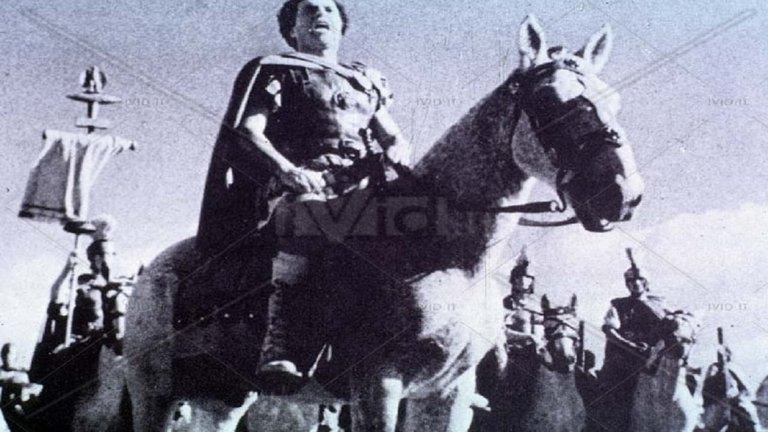Film Review: Scipio Africanus: The Defeat of Hannibal (Scipione l'Africano, 1937)

Italian military record in the Second World War is traditionally a source of ridicule, but a decade earlier, it was quite another story. Italians managed to pacify Libya, conquer Ethiopia, successfully intervene on the side of Nationalists in the Spanish Civil War, and invade Albania almost without a shot being fired. In those times, the idea of Italy restoring the Roman Empire, heavily promoted by Mussolini’s Fascist regime, didn’t look completely fantastic. Italian cinema contributed to those propaganda efforts with Scipio Africanus, a 1937 historical epic directed by Carmine Gallone (also known with the subtitle The Defeat of Hannibal), known as one of the most expensive and ambitious films of its era.
The plot is set during one of the most decisive episodes of ancient Roman history. In the late 2nd Century BC, Rome is fighting for hegemony over the Western Mediterranean with the rival city-state of Carthage. In 218 BC, during the Second Punic War, Carthaginian general Hannibal (played by Camillo Pillotto) invaded Italy and revealed himself to be a military genius, defeating every Roman army thrown against him. The last of these armies was annihilated on August 2nd, 216 BC, in the Battle of Cannae, resulting in the most devastating defeat in Roman history. Despite such losses, the Romans continued to fight with Hannibal, who, unable to conquer Rome itself, resorted to plundering the Italian countryside for the next decade. The only glimmer of hope for the Romans was brought by Publius Cornelius Scipio (played by Annibale Ninchi), a young general who scored a series of victories in Carthaginian-controlled Spain. Upon his return to Rome, he proposed a strategy based on sending an army to North Africa to attack the Carthaginian mainland, thus forcing Hannibal to leave Italy to protect it. Initially met with scepticism from senators like Cato the Elder (played by Memo Benassi), Scipio ultimately gained command of Roman forces in Sicily. When the Senate refused to reinforce and equip his army, ordinary citizens volunteered and brought supplies. After landing, Scipio formed an alliance with the Numidian leader Massinissa (played by Fosco Giachetti), and together they gradually achieved a series of victories, compelling the Carthaginian Senate to recall Hannibal to North Africa. The two generals finally met during the Battle of Zama, where Scipio aimed to avenge the defeat at Cannae and determine the outcome of the war and the future of the Mediterranean.
Italian cinema has a history of grandiose productions, including Cabiria, a silent film made nearly a quarter of a century earlier that dealt with a similar subject and characters. Scipio Africanus was even more grandiose, largely thanks to Mussolini, who sought to convince the audience that the Fascist state was not only the rightful heir of ancient imperial glory but also capable of repeating its greatest triumphs. Mussolini appointed his 21-year-old son Vittorio to oversee the Italian film industry personally, ensuring that director Carmine Gallone had everything he needed at his disposal. This included tens of thousands of extras, a large number of soldiers, expensive replicas of ancient galleys, and most notably, dozens of elephants used in the reconstruction of the Battle of Zama.
While the large budget is evident on screen, inevitable comparisons with Cabiria, even considering technological advancements, often favour the older film. Comparisons with Hollywood and other countries' historical epics are even less favourable for Gallone's film. Despite substantial resources, the production appears somewhat shoddy, with scenes lacking the epic or exciting quality, except for the opening in Rome and the final battle. Gallone's work shows rough edges, including embarrassing shots of extras wearing modern-day watches or telephone poles in the background. The script also falls short, with major historical events portrayed through pompous speeches, occasionally intertwined with subplots involving ordinary Romans, such as Hannibal's captive Velia (played by Isa Miranda) or soldiers in Scipio's army. The melodramatic subplot involving the Carthaginian princess Sophonisba (played by Francesca Braggiotti) is poorly executed.
The most intriguing and controversial aspect of Scipio Africanus is its dedication to historical accuracy, particularly in the reconstruction of the Battle of Zama, including the role of Hannibal's elephants and the tactics employed by the Romans against them. In an era before CGI, where bringing thousands of soldiers and numerous large animals on screen was a logistical challenge, this reconstruction represented an achievement that would not be surpassed for many decades. The film stands as one of the most accurate depictions of ancient warfare in 20th-century cinema. However, this accuracy came at a cost, as the animals had to be injured and even killed on set, a practice reminiscent of the producers of the Hollywood epic The Charge of the Light Brigade with horses a year earlier. This aspect of the film, depicting chaotic carnage involving both animals and humans, presents the harsh reality of war, somewhat contradicting the film's propaganda intentions. Despite winning a national film award under Mussolini's regime, Scipio Africanus did not achieve significant popularity, leading Mussolini to shift the Italian cinema industry towards more escapist forms of entertainment, such as "white telephone comedies." Gallone continued to make films post-World War II, revisiting similar themes in his 1960 "peplum" film Carthage in Flames. The Battle of Zama was later successfully recreated in the 2006 BBC docudrama Hannibal: Rome's Worst Nightmare, starring Alexander Siddig as Hannibal and Shaun Dingwall as Scipio.
RATING: 5/10 (++)
Blog in Croatian https://draxblog.com
Blog in English https://draxreview.wordpress.com/
Leofinance blog https://leofinance.io/@drax.leo
Unstoppable Domains: https://unstoppabledomains.com/?ref=3fc23fc42c1b417
Hiveonboard: https://hiveonboard.com?ref=drax
Bitcoin Lightning HIVE donations: https://v4v.app/v1/lnurlp/qrcode/drax
Rising Star game: https://www.risingstargame.com?referrer=drax
1Inch: https://1inch.exchange/#/r/0x83823d8CCB74F828148258BB4457642124b1328e
BTC donations: 1EWxiMiP6iiG9rger3NuUSd6HByaxQWafG
ETH donations: 0xB305F144323b99e6f8b1d66f5D7DE78B498C32A7
